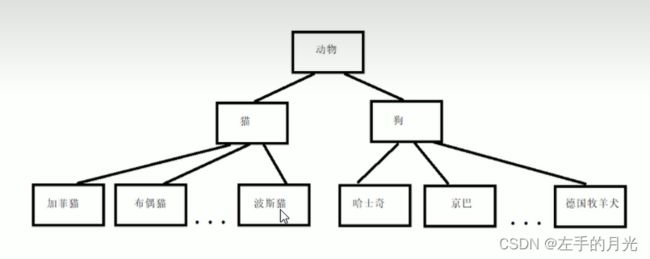浅谈C++|类的继承篇
引子:
继承是面向对象三大特性之一、有些类与类之间存在特殊的关系,例如下图中:

我们发现,定义这些类时,下级别的成员除了拥有上一级的共性,还有自己的特性。
这个时候我们就可以考虑利用继承的技术,减少重复代码。
一.继承基本语法
语法:class 子类:继承方式 父类
优点:减少重复代码
子类也叫派生类,父类也叫基类
代码:
#include
using namespace std;
class person { //定义person基类
public:
int age;
int height;
int weight;
string name;
void show() {
cout << "age=" << age << endl;
cout << "height=" << height << endl;
cout << "weight=" << weight << endl;
cout << "name=" << name << endl;
}
};
class women :public person {
public:
string xingbie;
void shou_x() {
cout << "xingbie=" << xingbie< 派生类中的成员,包含两大部分:
1.类是从基类继承过来的,-类是自己增加的成员。
2.从基类继承过过来的表现其共性,而新增的成员体现了其个性。
二.继承方式
继承方式:
public: 公有继承
protected:保护继承
private: 私有继承
代码:
#include
using namespace std;
class father {
public:
int A;
protected:
int B;
private:
int C;
};
class son1 :public father { //公有继承
public:
void fun() {
cout << "A=" << A << endl; //公有变为公有
cout << "B=" << B << endl; //保护变为保护
//cout << "C=" << C << endl;//私有不可访问
}
};
class son2 :protected father { //保护继承
public:
void fun() {
cout << "A=" << A << endl; //公有变为保护
cout << "B=" << B << endl; //保护变为保护
//cout << "C=" << C << endl;//私有不可访问
}
};
class son3 :private father { //私有继承
public:
void fun() {
cout << "A=" << A << endl; //公有变为私有
cout << "B=" << B << endl; //保护变为私有
//cout << "C=" << C << endl;//私有不可访问
}
};
void fun() {
son1 p1;
son2 p2;
son3 p3;
p1.A = 10;
p1.fun();
}
int main() {
fun();
return 0;
} 私有成员全不见,公不变,保全保,私全私。
三.继承中的对象模型
继承中,基类私有变量虽然访问不到,但是已经被继承,只是被隐藏了。
代码:
#include
using namespace std;
class father {
public:
int A;
protected:
int B;
private:
int C;
};
class son :private father {
public:
int age;
};
int main() {
cout << sizeof(son) << endl;
return 0;
} 四.继承构造和析构顺序
子类继承父类时,会先创建一个父类。析构的顺序和构造顺序正好相反。
代码:
#include
using namespace std;
class father {
public:
father() {
cout << "father的构造哈数" << endl;
}
~father() {
cout << "father的析构函数" << endl;
}
};
class son :public father {
public:
son() {
cout << "son的构造函数" << endl;
}
~son() {
cout << "son的析构函数" << endl;
}
};
void fun() {
son a;
}
int main() {
fun();
return 0;
} 五.继承同名成员处理方式
当基类中的成员变量以及成员函数,和派生类的成员变量和函数重名时,基类默认调用派生类的成员函数和成员变量。要想调用基类的成员函数和成员变量,需要加上基类的作用域;
代码:
#include
using namespace std;
class father {
public:
int A;
father() {
A = 999;
}
void fun() {
cout << "father的fun调用" << endl;
}
void fun(int a) {
cout << "father的fun调用" << ' ' << a << endl;
}
};
class son :public father{
public:
int A;
son() {
A = 99;
}
void fun() {
cout << "son的fun调用" << endl;
}
void fun(int a) {
cout << "father的fun调用" << ' ' << a << endl;
}
};
void fun() {
son p;
cout << "son" << ' ' << p.A << endl;
cout << "father" << ' ' << p.father::A << endl;
p.fun();
p.fun(11);
p.father::fun();
p.father::fun(90);
}
int main() {
fun();
return 0;
} 如果派生类中出现和基类重名的成员函数,那么派生类会隐藏基类全部重名的成员函数。需要注意的是,本来可以按照函数重载区分,却被派生类隐藏的情况:
代码:
#include
using namespace std;
class father {
public:
int A;
father() {
A = 999;
}
void fun() {
cout << "father的fun调用" << endl;
}
void fun(int a,int b) {
cout << "father的fun调用" << ' ' << a << endl;
}
};
class son :public father{
public:
int A;
son() {
A = 99;
}
void fun() {
cout << "son的fun调用" << endl;
}
};
void fun() {
son p;
cout << "son" << ' ' << p.A << endl;
cout << "father" << ' ' << p.father::A << endl;
p.fun();
p.fun();
p.father::fun();
//p.fun(90,89);//报错
p.father::fun(89, 123);
}
int main() {
fun();
return 0;
} 六.继承同名static成员处理方式
当重名的成员变量和函数是static时,需要注意通过类名来调用的方式
代码:
#include
using namespace std;
class father {
public:
static int A;
static void fun() {
cout << "father的fun调用" << endl;
}
void fun(int a) {
cout << "father的fun调用" << a<<' ' << endl;
}
};
int father::A=10; //static成员变量,类内声明,类外定义
class son :public father {
public:
static int A;
static void fun() {
cout << "son的fun调用" << endl;
}
};
int son::A = 20;
void fun() {
son p;
//1.利用对象调用成员变量和函数
cout << p.A << endl;
cout << p.father::A << endl;
p.fun();
p.father::fun();
cout << "**************************" << endl;
//2.利用类名调用成员变量和函数
cout << son::A << endl;
cout << father::A << endl;
cout << son::father::A << endl;
son::fun();
father::fun();
son::father::fun();
//father::fun(10); //报错,此方法只能调用static类型
}
int main() {
fun();
return 0;
} 七.多继承语法
C++中允许一个类继承多个类
语法: class子类∶继承方式父类1,继承方式父类2...
多继承可能会引发父类中有同名成员出现,需要加作用域区分
C++实际开发中不建议用多继承
代码:
#include
using namespace std;
class base1 {
public:
int A;
base1() {
A = 10;
cout << "base1构造函数调用" << endl;
}
};
class base2 {
public:
int A;
base2() {
A = 20;
cout << "base2构造函数调用" << endl;
}
};
class son :public base1, public base2 {
public:
int B;
int C;
son() {
B = 100;
C = 200;
cout << "son构造函数调用" << endl;
}
};
void fun() {
son b;
cout << b.base1::A << endl;
cout << b.base2::A << endl;
cout << b.B << endl;
cout << b.C << endl;
}
int main() {
fun();
return 0;
}
注意构造函数的调用顺序,父亲1先调用,父亲2再调用,最后son调用
总结:多继承中如果父类中出现了同名情况,子类使用时候要加作用域。
八.菱形继承
菱形继承概念:
两个派生类继承同一个基类
又有某个类同时继承者两个派生类
这种继承被称为菱形继承,或者钻石继承
1.羊继承了动物的数据,驼同样继承了动物的数据,当羊驼使用数据时,就会产生二义性。
2.羊驼将动物的数据继承了两份,其实我们应该清楚,这份数据我们只需要—份就可以。
代码:
#include
using namespace std;
class dongwu {
public:
int A;
};
class yang :public dongwu {};
class tuo:public dongwu {};
class son :public tuo, public yang {};
void fun() {
son p;
p.yang::A = 100;
p.tuo::A = 200;
//当菱形继承,两个父亲拥有相同名的成员时,要加作用域加以区分;
cout << p.yang::A << endl;
cout << p.tuo::A << endl;
}
int main() {
fun();
return 0;
} 此时的继承情况是,这样的。
利用虚继承,可以解决菱形继承的问题(两份相同的数据,浪费内存)
代码:
#include
using namespace std;
class dongwu {
public:
int A;
};
//virtual虚继承,dongwu称为虚基类
class yang :virtual public dongwu {};
class tuo:virtual public dongwu {};
class son :public tuo, public yang {};
void fun() {
son p;
yang p1;
tuo p2;
p.yang::A = 100;
p.tuo::A = 200;
p1.A = 90;
p2.A = 190;
//当菱形继承,两个父亲拥有相同名的成员时,要加作用域加以区分;
cout << p.yang::A << endl;
cout << p.tuo::A << endl;
cout << p1.A << endl;
cout << p2.A << endl;
}
int main() {
fun();
return 0;
} 继承时只继承一份,此时son继承的是两个虚基类表的指针,虚基类表中存储的是到成员的偏移量。
总结:
·菱形继承带来的主要问题是子类继承两份相同的数据,导致资源浪费以及毫无意义·利用虚继承可以解决菱形继承问题









